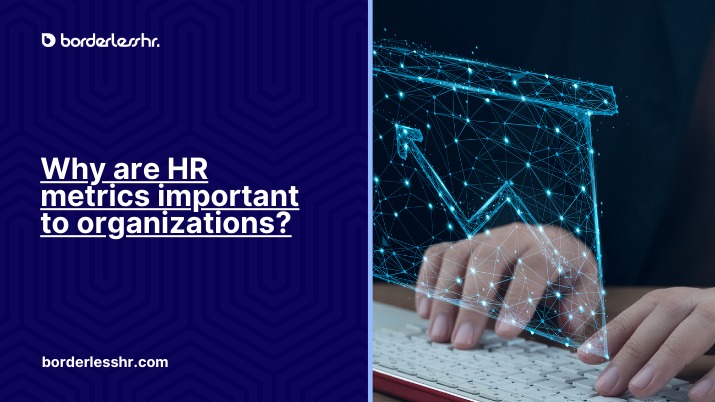Human resources is the essential foundation of an organization that makes sure that employees are working efficiently and effectively, and in today’s competitive landscape, organizations are increasingly recognizing the value of their human capital. A skilled and engaged workforce is vital for achieving strategic objectives and ensuring sustainable growth. However, measuring the effectiveness of human resource (HR) initiatives and the overall health of the workforce requires robust data-driven insights. This is where HR metrics come into play.
What are HR Metrics?
HR metrics are quantifiable measures that track various aspects of the employee lifecycle, encompassing recruitment, performance, engagement, training, and compensation. These metrics provide objective data that allows organizations to:
- Assess the efficiency and effectiveness of their HR programs and practices.
- Identify areas for improvement and optimize talent management strategies.
- Benchmark their performance against industry standards and best practices.
- Make data-driven decisions that align with the overall business strategy.
Benefits of Utilizing HR Metrics
Informed Decision-Making
Traditionally, HR decisions were often based on intuition and anecdotes. HR metrics offer tangible data to support decision-making, enabling organizations to:
- Evaluate the ROI of HR initiatives: Understand the financial impact of HR programs, such as training and development, and justify investments in these areas.
- Identify cost-saving opportunities: Analyze data to identify areas where expenses can be optimized, such as reducing turnover rates or improving recruitment efficiency.
- Develop targeted programs to address specific needs: Use data to identify gaps in employee skills or areas of low engagement and design targeted interventions to address them.
Improved Talent Management
HR metrics offer valuable insights into the workforce pipeline, allowing organizations to:
- Predict future talent needs: Analyze data on demographics, skills, and retirement trends to anticipate future talent gaps and develop proactive recruitment strategies.
- Identify high-potential employees: Use performance data to identify individuals who consistently exceed expectations and invest in their development through training and career advancement opportunities.
- Improve the employee experience: Track employee satisfaction and engagement levels, allowing organizations to identify areas where they can create a more positive and productive work environment.
Enhanced Business Performance
HR metrics go beyond just measuring HR activities; they can directly impact the bottom line of an organization. Studies show that companies with strong HR practices tend to outperform their peers financially. By utilizing HR metrics, organizations can:
- Boost productivity: Analyze data on performance and identify opportunities to improve efficiency and effectiveness in various departments.
- Reduce turnover: Track turnover rates and identify factors contributing to employee departure. Develop targeted initiatives to improve retention and minimize the associated costs of losing valuable employees.
- Enhance customer satisfaction: Engaged and motivated employees contribute to better customer service, leading to higher customer satisfaction and loyalty.
Building a Data-Driven HR Culture
Implementing HR metrics signifies a shift towards a data-driven mindset within the HR department. This fosters transparency and accountability, leading to:
- Improved collaboration between HR and other departments: HR can share data-driven insights with other business units to inform strategic decision-making.
- Increased focus on continuous improvement: Regularly tracking and analyzing metrics allows organizations to identify areas for improvement and constantly refine their HR practices.
- A culture of evidence-based decision-making: HR professionals gain credibility and become trusted advisors within the organization by utilizing data to support their recommendations.
Selecting and Implementing Effective HR Metrics
To ensure a thriving and productive environment, measuring the effectiveness of human resource (HR) initiatives is crucial. Organizations should select metrics that are aligned with their strategic goals, relevant to specific HR functions, and actionable. It’s also important to ensure that data is collected and analyzed accurately and consistently to avoid misinterpretations.
Examples of HR Metrics
HR metrics encompass a diverse range, categorized across various stages of the employee journey. Let’s explore some key examples under each category:
-
Recruitment & Onboarding
- Time-to-hire: Measures the average time taken to fill an open position, revealing the efficiency of the recruitment process.
- Cost-per-hire: Calculates the total cost associated with hiring a new employee, including advertising, interviewing, and onboarding.
- New hire turnover rate: Tracks the percentage of new hires leaving the company within a specific timeframe, indicating potential issues in the onboarding process or company fit.
- Offer acceptance rate: Signals the percentage of candidates accepting job offers, reflecting the attractiveness of the company and the offer itself.
-
Performance & Productivity
- Individual and team performance metrics: Can include various data points depending on the role and department, such as sales figures, customer satisfaction ratings, or project completion rates.
- Absenteeism rate: Measures the frequency of employee absences, potentially indicating health concerns, low morale, or inadequate scheduling.
- Productivity rates: Evaluate the output per employee hour, allowing organizations to assess efficiency and identify areas for improvement.
-
Engagement & Culture
- Employee satisfaction surveys: Gauge employee sentiment towards various aspects of the work environment, including leadership, compensation, and work-life balance.
- Pulse surveys: Short, frequent surveys addressing specific topics, providing real-time insights into employee engagement and concerns.
- Internal referral rate: Indicates the number of employees referring their networks for job openings, reflecting employee satisfaction and company advocacy.
-
Training & Development:
- Training completion rate: Measures the percentage of employees completing assigned training programs.
- Impact of training on skills and performance: Analyses the effectiveness of training programs in enhancing employee skill sets and improving performance metrics.
- Skills gap analysis: Identifies the discrepancies between existing skills within the workforce and the skills required for future needs, informing training and development strategies.
-
Compensation & Benefits:
- Compensation ratio: Compares the average salary of a specific position within the organization to the market average for the same position.
- Employee turnover cost: Calculates the financial impact of employee turnover, including lost productivity, recruitment costs, and knowledge transfer expenses.
- Pay equity analysis: Ensures fair and equal pay practices across various demographics within the organization.
While these are just some examples, remember that selecting the right HR metrics depends on the specific needs and goals of each organization. The key lies in choosing metrics that are aligned with strategic objectives, relevant to specific HR functions, and ultimately actionable.
Conclusion
In conclusion, HR metrics are no longer an optional add-on, but an essential tool for any organization seeking sustainable growth and competitive advantage. By utilizing data insights effectively, organizations can optimize their HR practices, build a strong and engaged workforce, and ultimately achieve their business objectives. As the saying goes, “what gets measured, gets managed,” and HR metrics are the key to unlocking the full potential of your most valuable asset – your people.







